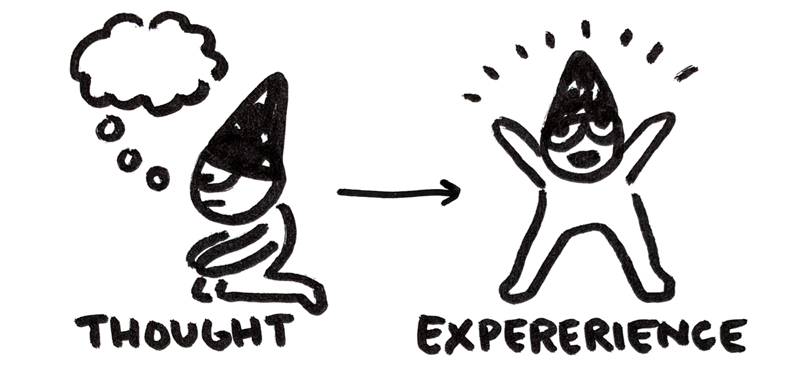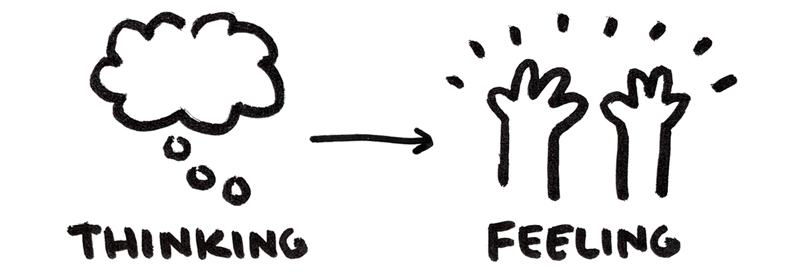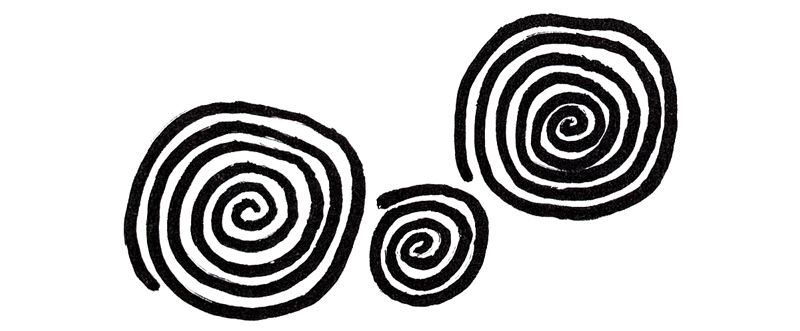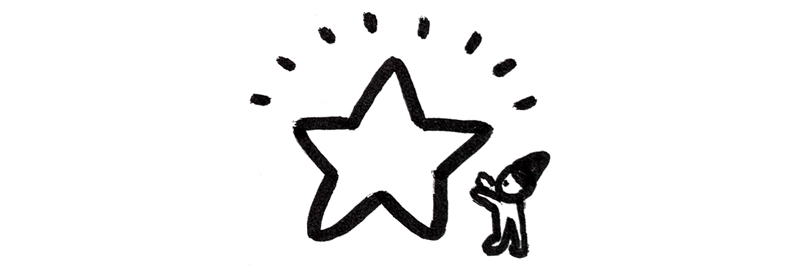
📝 NOTE: This is an ongoing series on my theory of Artistic Intelligence (AQ). New here? You can read the first essay in the series here.
The Mental Shifts of AQ
There are 7 mental shifts that must happen for us to move from a Toxic to Nourishing mindset. This week, I’m covering the second mental shift, and you can see the previous shifts below.
- Shift 1: Unaware while making art → intentional while making art
- Shift 2: Thinking while making art→ Experiencing while making art
The Scenario
Imagine the following scenario:
You’re drawing something in your sketchbook. You’re finding it difficult to concentrate. You sat down with the intention of drawing it “right” this time. But as soon as you started drawing, you already messed it up. You wonder why you chose to draw this thing in the first place. You wonder why you can’t just draw better. You spend the rest of the time frustrated with yourself, remembering all the other times you’ve messed up, and eventually you give up and stop drawing.
Does this resonate with you?
Lost in Our Thoughts
The experience above illustrates being lost in thought while drawing. These thoughts often hover around planning what we’ll do next, noticing mistakes we’ve made, or wishing for different outcomes. There certainly isn’t a problem with thinking, but it is a problem when we become lost in thought while we’re making art.
Present in Our Experience
When swept up in thinking, we’re not paying attention to what’s happening on the page. We’re living up in our heads, distracted by the loud voices telling us what we’ve done wrong or what we should do next.
Rather than connecting with our art through our thoughts, we can connect with our art through our experience. Instead of thinking so much while drawing, we can practice feeling and sensing while drawing.
This sounds a little woo-woo, I know. But, stick with me, I promise it’s practical.

Thinking vs Feeling
So what’s the difference between thoughts and feelings? Thoughts are the words and continuous monologue running in our heads. Feelings are the sensations in us that can’t easily be described in words—they must be felt.
When we draw, we naturally have both thoughts and feelings. For example, if you’re drawing a make a mistake, you may have the following:
Thought: “Ugh, I can’t draw this character right, how will I ever get a book deal?”
Feeling: Worried
Thought: “Dang it, I already screwed up again. I’m such an idiot.”
Feeling: Angry
Both of those examples come from the same scenario—making a mistake while drawing—but each one illustrates a different interpretation of the situation.
If we think about future goals while drawing, we may feel worried we’ll never achieve them. If we think about past mistakes while drawing, we may feel angry we’re not improving faster.
In this way, our experience is shaped by our interpretation of the experience, rather than the actual experience. Those interpretations are influenced by our beliefs and past experiences, just as much, or more so than the situation.
Interpretation vs Reality
Because we can have multiple different interpretations of the same situation, they can’t all be accurate reflections of reality. And so, it follows that thoughts are not reality—they’re just thoughts.
Think of a time you tried to sit down and draw when you were feeling depressed or in a low mood. You probably interpreted the situation negatively. Maybe you made a tiny mistake, then thought about what a dumb mistake it was, and how this the eleven-ty-billion-th time you’ve done that, and ugh, you’re just so bad at this!
The thing is, those thoughts are not accurately reflecting what happened while we were drawing. Your thoughts pulled you out of the actual experience and into your head. When this happens, we’re not able to clearly see and feel what we’re drawing—we’ve been thrown out of the present moment and into our past regrets and the future worries.
Somehow our mind thinks these thoughts are going to help us solve our problems and get better at drawing. But that kind of negative interpretation just makes us feel worse. When we’re lost in our thoughts, we’re more likely to see the next mistake even more negatively, spiraling down and down, until eventually we quit drawing for the day (or for good.)
It’s those kinds of thought spirals that lead to depression and anxiety. It’s that kind of thinking that gets stuck up in our heads and separates us from the experience of drawing.
So we have to learn how to step out of that spiral. We have to shift from thinking while making art to experiencing while making art.
I’ve developed a couple exercises to help us practice doing that. Let’s try it!

Exercise 1: Relaxation Spirals
For this exercise you’ll need: Your sketchbook (or paper), a pen or pencil, and a timer. Please read through the instructions before you begin.
- Go somewhere where you can be alone and free of distractions.
- Set your timer to 5 minutes and hit start.
- Put your pen to the paper, and hold it there—not moving for a moment—and take a deep breath. Slowly inhale and exhale.
- Now begin to move your pen, drawing a tight spiral around the point you started on. Keep drawing the spiral out, ring by ring, keeping the lines as close together as possible without touching. Move the pen slowly, taking your time. If you run out of room, begin a new spiral on the same page.
- While you draw the spirals, focus your attention on your breath. Guide your awareness to your inhale and exhale. If you find your attention drifting off to your thoughts, just gently bring your attention back to your breath.
- Continue until the timer beeps.
Exercise 2: Notice the Good
For this exercise you’ll need: Your sketchbook (or paper), and a pen or pencil. Please read through the instructions before you begin.
- The next time you sit down to draw, make an intention to notice one good thing while you’re drawing. Perhaps you like the thickness of a line you drew, or the texture of the paper, or the color palette you chose.
- When you notice something you like, jot down your answers to the following questions on the next page of your sketchbook or piece of paper:
- What is it you liked/enjoyed?
- What physical sensations did you feel while drawing it? (Did you smile? Sigh? Relax your shoulders?)
- What feelings did you have while drawing it? (Did you feel happy? Excited? Curious?)
- What thoughts were you thinking while drawing it?
- What are you thinking now as you reflect on the experience?

Help + Tips
Did you find yourself getting bored or thinking nothing is happening for you during these exercises?
That’s ok! It’s your mind again, trying to push it’s way back in. Try to simply notice those thoughts as what they are—thoughts. These kinds of thoughts are often more of a reflection of your mood and mindset than the way things really are. You may be interpreting the experience based on prior experiences or current moods. Try labeling the thoughts as “thinking” to separate yourself from them a bit. Try to shift your attention from getting lost in your thoughts to focusing on your physical sensations and direct experience while drawing instead.
I keep meaning to do this exercise, but haven’t yet. I feel bad, but I just keep forgetting or not having time to do it.
This is your mind busting through again, barreling in with all its judgements in tow! These kinds of guilty thoughts throw us into a negativity spiral where we blame ourselves for not drawing, then avoid drawing, then blame ourselves for not drawing, leading to less drawing, and on and on.
Try to not judge what has happened in the past. Let go of yesterday, and focus on the now. Whatever you did or didn’t do in the past, you can always do something different today. Try to focus your attention on doing the exercise, rather than thinking about how you haven’t done it yet.
I got lost in thought during the exercise and swept up in a spiral of negative judgements, when I was supposed to be noticing the good or focusing on my breathing. What’s wrong with me?!
Hey, it’s ok! That’s normal, and this is all a process. We’ve got to learn and practice these things, and it will take time to get the hang of it. When you notice you’re getting caught up in your thoughts, first of all, pat yourself on the back! You noticed you were getting sucked up in your head, and that awareness is the first step.
Next, try not to take those thoughts so seriously. By not immediately buying into them and believing them, the thoughts become weaker and can fade away more easily. You can also try to just allow them to be there rather than fighting against them. We’ll never be able to get rid of all our thoughts (and that’s not even the goal). So we have to learn and practice allowing our thoughts to be there, and then consciously choosing what we want to focus on. We can notice the thoughts, label them for what they are, and bring our attention back to our experience—back to drawing.
THAT’S the goal: to shift our awareness from thinking about drawing, to actually drawing.

Why We Did It
Our thoughts guide our interpretation of our experience, and can get us stuck in ruts, following the same negative thought patterns over and over. For example, in a depressed mindset, we are more likely to notice what’s wrong with our art while drawing.
Our first exercise here allows us to practice quieting our thoughts and stepping back into the present moment. It encourages us to pay attention to our actual experience, rather than our interpretation of it.
The second exercise allows us to focus on a good experience while drawing and notice what it feels like, rather than immediately thinking about it and potentially talking ourselves out of it. Consciously noticing and reflecting on a positive drawing experience reminds us of the joy that is always there in our art making experience, but perhaps we had stopped noticing in our interpretations.
❓What do you think?
I’d love to hear what you think of these concepts and exercises! Head over to Might Could Studiomates to join the group discussion (did you know we have a free plan now?) or comment below to share your thoughts!

